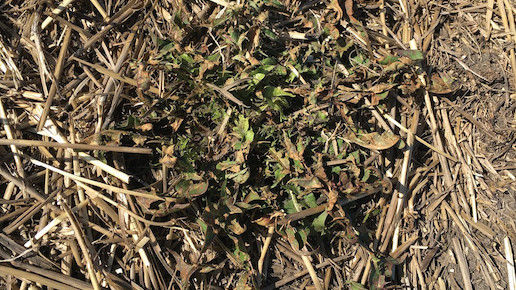5 READ-TIME
Set your field up for success by managing fall weeds
November 30, 2023

By Jennifer Barber
As the season draws to a close, it's time to celebrate a job well done. But as growers know, even as the combine shuts down, there is still work to do. As long as weeds continue to grow, they can cause problems for the next season
There are lots of reasons to control fall weeds both pre- and postharvest,” says Rory Cranston, North American technical development manager, cereals and pulses with Bayer. “Most of those reasons involve thinking ahead. A pre-harvest weed control means that a grower will be making things easier when combining. Cleaning up the field after harvest will set them up for success in the coming year.”
“Fall weeds will populate the weed seed bank,” says Carly Owen, an agronomist with Field 2 Field Agronomy in Carman, MB. “They can rob the soil of nutrients and depending on the weed type — such as a perennial weed like Canada thistle or foxtail barley — it can cause you big problems in the spring.”
While the costs of farming have, like everything else, increased this year, ultimately the value of the crop and keeping the crop profitable should be top of mind when it comes to fall weed management. At the end of the season, poor agronomic decisions made to save costs, will not pay off.
Owen and Cranston offer some thoughts about fall weed management this year.
SCOUT PROPERLY
Good scouting remains one of the best ways for growers to stay on top of fall weed concerns. “Growers should always have a shadow on the field,” says Cranston. “It sounds simple, but even at the end of the season they should be scouting the field to see what is green. From there they can better target what kind of control they need.”
KNOW YOUR PRODUCTS
Farmers get one shot to set up their field for the next season, but the plan for the fall is likely part of a complete, season-long weed control plan. Keep careful records to make sure you know what chemical groups you’ve used throughout the season, what the pre-harvest intervals are for different chemistries and identify any resistance issues you may have.
For residual herbicides, consider the following year’s crop because while a herbicide may be effective on troublesome weeds, it might not meet registration standards for the next crop in rotation. If you are unsure what the next crop will be, consider using something less risky with no residual restrictions for the following spring.
TANK-MIXES AND ADDITIVES
A carefully considered tank-mix with multiple modes of action will help you stay ahead of most resistance concerns. Growers should know their enemy and what kind of plant populations they have before deciding what tank-mix strategy to use to target fall weeds. For a pre-harvest herbicide, Owen says that additives should also be considered, depending on the conditions.
“The weed itself will be doing whatever it can to continue, even if it is hot and dry leading up to harvest and the crop matures quickly,” she says. “Weeds are more difficult to kill if they have hardened off and they are not going to take a herbicide as easily. In that case I recommend growers add in a surfactant or an MSO adjuvant to help with the herbicide uptake. It’s fairly cost-effective and you want to make sure you get an effective weed kill to help with herbicide resistance.”
THE IMPLICATIONS OF WEATHER
Last year, an early harvest allowed plenty of time for fall weeds to progress, along with extra time for farmers to get into the field to see what was going on before making a post-harvest herbicide application.
That kind of open fall provides the most options for effective control because weeds are actively growing and therefore more vulnerable to herbicide activity. But fall — open or not — can be a time of heavy dews and cooler nighttime temperatures, so keep an eye on the weather and spray accordingly.
For instance, a systemic herbicide requires temperatures to be at least 8° C for two or three days before or after application. If you’re hit by a frost, wait a few days until the weeds have recovered and are actively growing again before spraying. Wait until dew has evaporated before spraying as this improves uptake.
AVOID SHORT CUTS
“I tell growers not to skimp on water with the idea of saving time,” says Owen. “If you are going in to control weeds you want to make sure you are actually going to get the control you are looking for.” As well, always follow label directions as cutting rates can cause bigger problems in the future in terms of weed populations and resistance issues.
“It costs zero dollars to go into your field and see what is going on,” says Cranston. “Sometimes the weed spread is sporadic, and you can use precision technology to spot apply a herbicide. But the key is to understand what you are dealing with. Before or after harvest, make sure you know your crop stage, your weed stage and whether your chemical will have an impact on your ability to market your crop, and then you can get to work on the weeds.”
